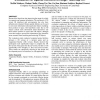Free Online Productivity Tools
i2Speak
i2Symbol
i2OCR
iTex2Img
iWeb2Print
iWeb2Shot
i2Type
iPdf2Split
iPdf2Merge
i2Bopomofo
i2Arabic
i2Style
i2Image
i2PDF
iLatex2Rtf
Sci2ools
CHINZ
2007
ACM
2007
ACM
Evaluation of spatial abilities through tabletop AR
Research has been done into improving the means by which we organise and manage information. The usefulness of 2D versus 3D interfaces and environments has also been debated and evaluated. Human spatial abilities can be used to store more information about particular objects including their position in space. Our hypothesis states that as 3D objects contain more information about themselves and their relative position in space than 2D objects, although users take longer to process this information, they should be more accurate when searching and retrieving 3D objects. The evaluation study conducted compared spatial abilities between a 2D version of a memory game and an Augmented Reality (AR) version. Results showed that participants took significantly longer to complete the AR 3D version of the game than the 2D version, but did so with significantly fewer attempts i.e. they were more accurate. These results are specifically relevant for the design and development process of interfaces...
AR 3D Version | CHINZ 2007 | Human Computer Interaction | Human Spatial Abilities | Spatial Abilities |
| Added | 13 Aug 2010 |
| Updated | 13 Aug 2010 |
| Type | Conference |
| Year | 2007 |
| Where | CHINZ |
| Authors | Moffat Mathews, Madan Challa, Cheng-Tse Chu, Gu Jian, Hartmut Seichter, Raphael Grasset |
Comments (0)

